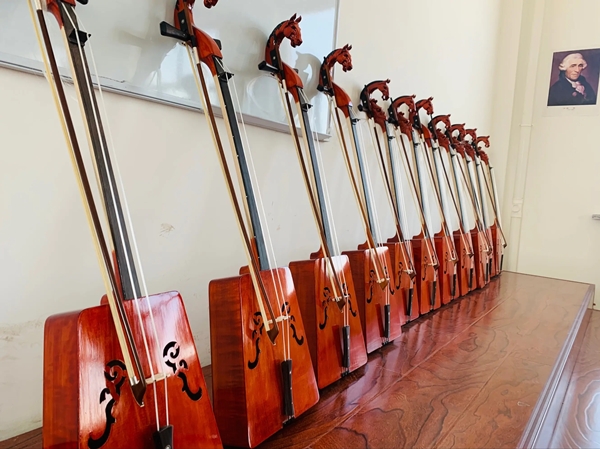Playing posture and method of matouqin
What is the posture and method of playing the matouqin? Teach you the basic playing method of matouqin from three aspects: sitting posture, fingering, and bowing.

sitting position
When playing the matouqin, you usually take a seated position, with the piano box sandwiched between your legs, and the piano bar leaning to the left.
fingering
The tiger's mouth of the left hand is naturally open, and the thumb is slightly supported on the piano rod. In the low position, use the base of the fingernail of the index finger and middle finger to tie the string, and the ring finger and little finger use the fingertip to tie the string. The little finger is very important in playing, and it often stretches from under the outer string. Go into the top string; on the high position, due to the small distance between the phonemes, each finger presses the string with the fingertips. When holding the bow with the right hand, the handle of the bow is clamped with the tiger's mouth, the index finger and middle finger are placed on the bow shaft, and the ring finger and the little finger control the bow hair.
bow
During bowing, the bow hair and the strings should be kept at right angles. There are many kinds of tunings for the matouqin. Because the thinner strings are on the inner strings and the thicker strings are on the outer strings, they are often tuned in inverse fourths as g and c1, and sometimes in positive fourths as d1 and a. , the positive fifth relationship is singed as d1, g. The method of playing is also different from other stringed instruments. The bow hair of the bow is not sandwiched between the inner and outer strings, but is played on the outside of the two strings, so it has a unique timbre, soft, thick and deep. , especially broad, deep and unrestrained, full of grassland flavor. Right-handed bows include longbow, half-bow, short-bow, jumping bow, even bow, even jumping bow, slamming bow, hitting bow, smashing bow, broken bow and trembling bow, etc. The left-hand fingering method includes strumming, picking, vibrato, Techniques such as strumming, glissando, double tones, plucking, vibrato, and overtones, many ornamental notes are played by the little finger. The performance of the matouqin is that the fingernails touch the strings from the side of the strings, so the timbre is clear and bright, suitable for playing rich overtones, and has a distinct artistic style.
 渝公网安备 50010702504639号
渝公网安备 50010702504639号